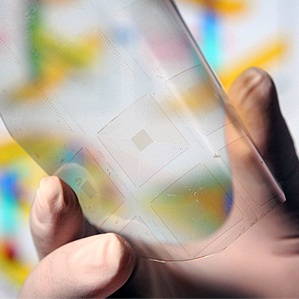Nanoscale Pressure Sensors Mimic Human Skin
Arrays of transistors made of nanowires could form the basis of a new class of devices nearly as sensitive to mechanical force as human skin is, according to research published today in Science.

The inventor of the technology, Zhong Lin Wang, a professor of materials science and engineering at Georgia Tech, says it has immediate applications in human-machine interfaces. For example, it could be used to capture electronic signatures by recording the distinctive force an individual applies while signing. Down the road, says Wang, his group’s pressure sensor arrays could equip robotics and prosthetics with a human-like sense of touch.
Electronically replicating the sensitivity of the human sense of touch has proved extremely challenging. Recently, some research groups have demonstrated that micro- or nanoelectronics assembled on flexible, bendable substrates could monitor pressure changes at a fairly high level of detail and thus could potentially act as a kind of “artificial skin.”
In the new research, Wang’s group demonstrates nanoelectronics that offer at least a 15-fold enhancement in sensor density and spatial resolution compared to the previous approaches. Further, the electronic properties of the nanowires allowed the researchers to demonstrate through high-resolution imaging an improvement in sensitivity of two to three orders of magnitude. The density, resolution, and sensitivity of the sensors, says Wang, is comparable to that of the skin of a human finger.
Made from nanoscale crystals of the semiconducting material zinc oxide, the nanowires are piezoelectric, meaning they generate an electrical charge in response to applied mechanical force. Wang and his colleagues have taken advantage of this effect, using the wires to build a new type of transistor that works without added voltage (see 10 Breakthrough Technologies 2009: Nanopiezoelectronics).
In Wang’s nanowire transistors, the gate traditionally used in electronics is eliminated. Instead, the current flowing through the nanowires is controlled by the electrical charge generated when strain or force applied is to the transistors.
Wang’s transistors can convert mechanical signals into electronic signals with a much higher degree of sensitivity compared to previous nanoscale approaches to tactile sensing, which rely on recording changes in capacitance or resistance in response to applied force or strain.
The researchers also showed that the sensing ability of the nanowire transistor array does not diminish when its substrate is deformed, demonstrating its potential utility in flexible electronics. The nanowires and the associated electrode can be deposited and grown at a relatively low temperature, says Wang, “on any substrate, from soft polymers to ceramics to wafers.”
As for giving robots human-like touch sensitivity, designing better sensors is only part of the task. Perhaps the bigger challenge is integrating them into a system that can interpret the sensors’ signals and respond instantaneously. Wang says his group will now focus on developing such a system, and on even further improving the density of nanowire sensors they can fabricate on a single array.
Keep Reading
Most Popular
Large language models can do jaw-dropping things. But nobody knows exactly why.
And that's a problem. Figuring it out is one of the biggest scientific puzzles of our time and a crucial step towards controlling more powerful future models.
How scientists traced a mysterious covid case back to six toilets
When wastewater surveillance turns into a hunt for a single infected individual, the ethics get tricky.
The problem with plug-in hybrids? Their drivers.
Plug-in hybrids are often sold as a transition to EVs, but new data from Europe shows we’re still underestimating the emissions they produce.
Stay connected
Get the latest updates from
MIT Technology Review
Discover special offers, top stories, upcoming events, and more.